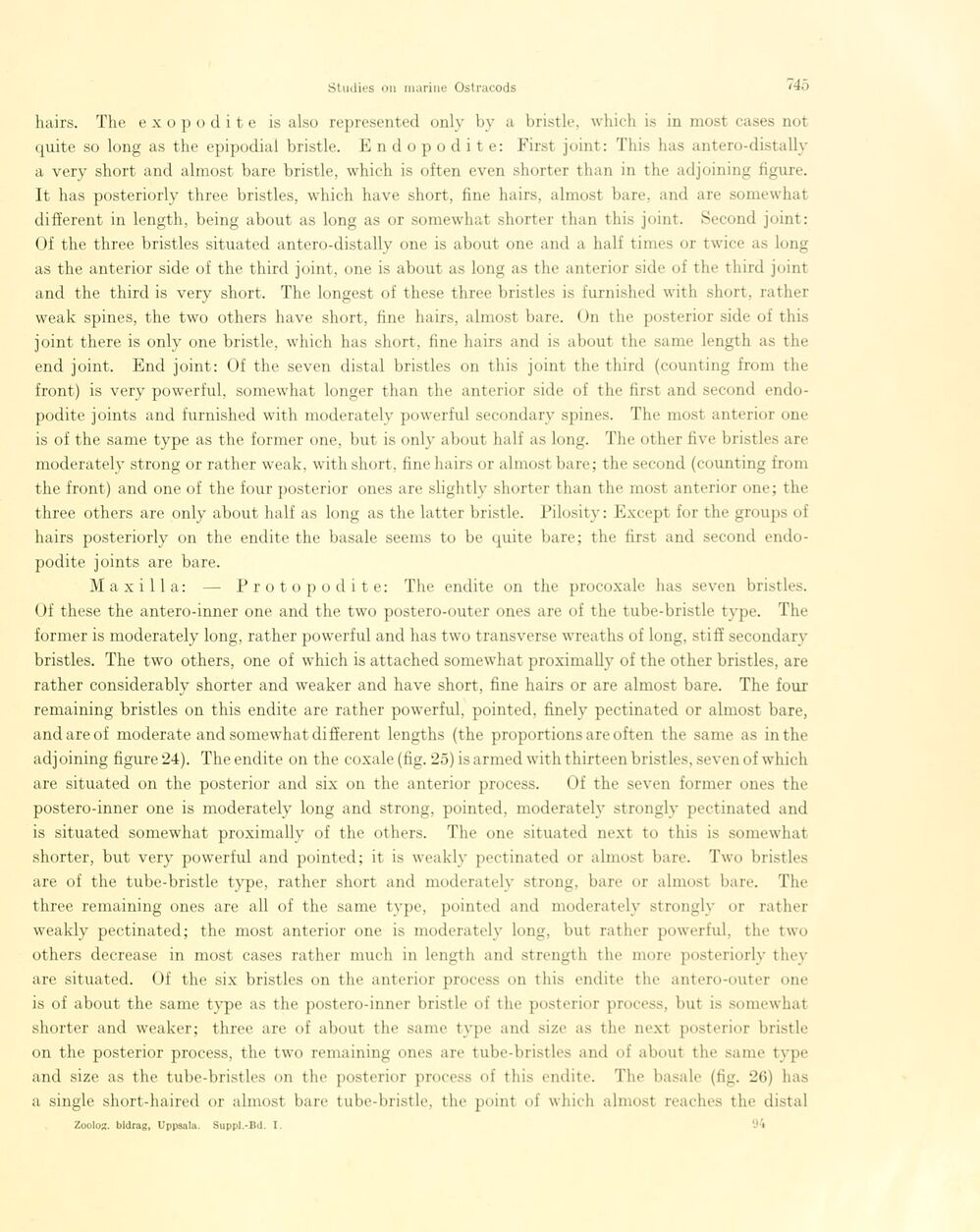
Full resolution (JPEG) - On this page / på denna sida - Sidor ...

<< prev. page << föreg. sida << >> nästa sida >> next page >>
Below is the raw OCR text
from the above scanned image.
Do you see an error? Proofread the page now!
Här nedan syns maskintolkade texten från faksimilbilden ovan.
Ser du något fel? Korrekturläs sidan nu!
This page has never been proofread. / Denna sida har aldrig korrekturlästs.
hairs. The exopodite is also represented only by a bristle, which is in most cases not
quite so long as the epipodial bristle. E n d o p o d i t e: First joint: This has antero-distally
a very short and almost bare bristle, which is often even shorter than in the adjoining figure,
lt has posteriorly three bristles, which have short, fine hairs, almost bare, and are somewhat
different in length, being about as long as or somewhat shorter than this joint. Second joint:
Of the three bristles situated antero-distally one is about one and a half times or twice as long
as the anterior side of the third joint, one is about as long as the anterior side of the third joint
and the third is very short. The longest of these three bristles is furnished with short, rather
weak spines, the two others have short, fine hairs, almost bare. On the posterior side of this
joint there is only one bristle, which has short, fine hairs and is about the same length as the
end joint. End joint: Of the seven distal bristles on this joint the third (counting from the
front) is very powerful, somewhat longer than the anterior side of the first and second
endo-podite joints and furnished with moderately powerful secondary spines. The most anterior one
is of the same type as the former one, but is only about half as long. The other five bristles are
moderately strong or rather weak, with short, fine hairs or almost bare; the second (counting from
the front) and one of the four posterior ones are slightly shorter than the most anterior one; the
three others are only about half as long as the latter bristle. Pilosity: Except for the groups of
hairs posteriorly on the endite the basale seems to be quite bare; the first and second
endo-podite joints are bare.
Maxilla: — Protopo dite: The endite on the procoxale has seven bristles.
Of these the antero-inner one and the two postero-outer ones are of the tube-bristle type. The
former is moderately long, rather powerful and lias two transverse wreaths of long, stifî secondary
bristles. The two others, one of which is attached somewhat proximally of the other bristles, are
rather considerably shorter and weaker and have short, fine hairs or are almost bare. The four
remaining bristles on this endite are rather powerful, pointed, finely pectinated or almost bare,
and are of moderate and somewhat different lengths (the proportions are often the same as in the
adjoining figure 24). The endite on the coxale (fig. 25) is armed with thirteen bristles, seven of which
are situated on the posterior and six on the anterior process. Of the seven former ones the
postero-inner one is moderately long and strong, pointed, moderately strongly pectinated and
is situated somewhat proximally of the others. The one situated next to this is somewhat
shorter, but very powerful and pointed; it is weakly pectinated or almost bare. Two bristles
are of the tube-bristle type, rather short and moderately strong, bare or almost bare. The
three remaining ones are all of the same type, pointed and moderately strongly or rather
weakly pectinated; the most anterior one is moderately long, but rather powerful, the two
others decrease in most cases rather rnuch in length and strength the more posteriorly they
are situated. Of the six bristles on the anterior process on this endite the antero-outer one
is of about the same type as the postero-inner bristle of the posterior process, but is somewhat
shorter and weaker; three are of about the same type and size as the next posterior bristle
on the posterior process, the two remaining ones are tube-bristles and of about the same type
and size as the tube-bristles on the posterior process of this endite. The basale (fig. 26) has
a single short-haired or almost bare tube-bristle, the point of which almost reaches the distal
Zoolog, bidrag, Uppsala. Suppl.-Bd. I. 94
<< prev. page << föreg. sida << >> nästa sida >> next page >>